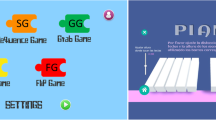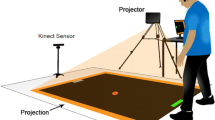Abstract
Background
Exergaming has been suggested as a rehabilitation method since it is more motivational for people with multiple sclerosis (MS, pwMS). However, the major disadvantage of this method is the lack of specific scenarios designed for pwMS.
Objectives
This study aims to assess the feasibility of exergaming, which was developed for pwMS.
Methods
This unblinded prospective clinical trial was performed in the outpatient MS Clinic of Dokuz Eylül University Hospital. Exergaming scenarios were developed in collaboration with medical personnel consisting of physiotherapists and doctors, and computer engineers. A total of 30 participants who had definite MS diagnoses were included. The exergaming scenarios were implemented using the Microsoft Kinect. A physiotherapist applied custom-made exergames for one session. All the participants were assessed immediately after the session. The User Satisfaction Evaluation Questionnaire was used to assess the user’s satisfaction with the system and exergaming.
Results
The mean age was 41.5, the mean Expanded Disability Status Scale was 4.5 (range between 0 and 7), and the mean disease duration was 10.0 years. Twenty patients were relapsing–remitting, and 10 were secondary-progressive. The mean scores of the User Satisfaction Evaluation Questionnaire were 4.33 (SD = 0.84) for helpfulness for rehabilitation, 1.63 (SD = 1.1) for not disturbing, 4.50 (SD = 1.07) for understandability, 4.0 (SD = 0.91) for easiness to control, and 4.33 (SD = 0.84) for enjoyability.
Conclusion
These results showed that our custom-made exergaming scenario could be feasible in upper extremity rehabilitation in MS. More research is needed to investigate its effectiveness in the rehabilitation of upper limbs.




Similar content being viewed by others
Data availability
The authors declare that they have written entirely original work, and if the authors have used the work and/or words of others, then this has been appropriately cited or quoted. All data and materials will be furnished upon request.
References
Filippi M, Bar-Or A, Piehl F et al (2018) Multiple sclerosis. Nat Rev Dis Primers 4:43. https://doi.org/10.1038/s41572-018-0041-4
Quinn É, Hynes SM (2021) Occupational therapy interventions for multiple sclerosis: a scoping review. Scand J Occup Ther 28:399–414. https://doi.org/10.1080/11038128.2020.1786160
Kubsik A, Klimkiewicz P, Klimkiewicz R et al (2017) Rehabilitation in multiple sclerosis. Adv Clin Exp Med 26:709–715. https://doi.org/10.17219/acem/62329
Lamers I, Maris A, Severijns D et al (2016) Upper limb rehabilitation in people with multiple sclerosis. Neurorehabil Neural Repair 30:773–793. https://doi.org/10.1177/1545968315624785
Pilloni G, Malik M, Malik R et al (2021) Upper extremity motor fatigability as an early indicator in pediatric onset multiple sclerosis. J Child Neurol 36:720–726. https://doi.org/10.1177/0883073821999889
Johansson S, Ytterberg C, Claesson IM et al (2007) High concurrent presence of disability in multiple sclerosis. J Neurol 254:767–773. https://doi.org/10.1007/s00415-006-0431-5
Bertoni R, Lamers I, Chen CC et al (2015) Unilateral and bilateral upper limb dysfunction at body functions, activity and participation levels in people with multiple sclerosis. Mult Scler J 21:1566–1574. https://doi.org/10.1177/1352458514567553
Fasczewski KS, Gill DL, Rothberger SM (2018) Physical activity motivation and benefits in people with multiple sclerosis. Disabil Rehabil 40:1517–1523. https://doi.org/10.1080/09638288.2017.1300946
Karakas H, Seebacher B, Kahraman T (2021) Technology-based rehabilitation in people with multiple sclerosis: a narrative review. J Multiple Scler Res 1:54–58. https://doi.org/10.4274/jmsr.galenos.2021.2021-10-3
Calafiore D, Invernizzi M, Ammendolia A et al (2021) Efficacy of virtual reality and exergaming in ımproving balance in patients with multiple sclerosis: a systematic review and meta-analysis. Front Neurol 12:773459. https://doi.org/10.3389/fneur.2021.773459
Massetti T, Trevizan IL, Arab C et al (2016) Virtual reality in multiple sclerosis–a systematic review. Mult Scler Relat Disord 8:107–112. https://doi.org/10.1016/j.msard.2016.05.014
Nascimento AS, Fagundes CV, dos Mendes FA, S, Leal JC, (2021) Effectiveness of virtual reality rehabilitation in persons with multiple sclerosis: a systematic review and meta-analysis of randomized controlled trials. Mult Scler Relat Disord 54:103128. https://doi.org/10.1016/j.msard.2021.103128
Chadali A, Trevlaki E, Zarra E, Trevlakis E (2023) Virtual reality in upper extremity rehabilitation of multiple sclerosis patients. Int J Sci Res Arch 9:302–308. https://doi.org/10.30574/ijsra.2023.9.2.0549
Taylor M, Griffin M (2015) The use of gaming technology for rehabilitation in people with multiple sclerosis. Mult Scler J 21:355–371. https://doi.org/10.1177/1352458514563593
Burdea GC (2003) Virtual rehabilitation–benefits and challenges. Methods Inf Med 42:519–523
Thompson AJ, Banwell BL, Barkhof F et al (2018) Diagnosis of multiple sclerosis: 2017 revisions of the McDonald criteria. Lancet Neurol 17:162–173. https://doi.org/10.1016/S1474-4422(17)30470-2
Kurtzke JF (1983) Rating neurologic impairment in multiple sclerosis: an expanded disability status scale (EDSS). Neurology 33:1444–1452. https://doi.org/10.1212/wnl.33.11.1444
Gil-Gómez J-A, Manzano-Hernández P, Albiol-Pérez S et al (2017) USEQ: a short questionnaire for satisfaction evaluation of virtual rehabilitation systems. Sensors 17:1589. https://doi.org/10.3390/s17071589
Jonsdottir J, Bertoni R, Lawo M et al (2018) Serious games for arm rehabilitation of persons with multiple sclerosis. A randomized controlled pilot study. Mult Scler Relat Disord 19:25–29. https://doi.org/10.1016/j.msard.2017.10.010
Jonsdottir J, Perini G, Ascolese A et al (2019) Unilateral arm rehabilitation for persons with multiple sclerosis using serious games in a virtual reality approach: bilateral treatment effect? Mult Scler Relat Disord 35:76–82. https://doi.org/10.1016/j.msard.2019.07.010
Kalron A, Frid L, Fonkatz I et al (2022) The design, development, and testing of a virtual reality device for upper limb training in people with multiple sclerosis: single-center feasibility study. JMIR Serious Games 10:e36288. https://doi.org/10.2196/36288
Funding
The authors received no financial support for the research, authorship, and/or publication of this article.
Author information
Authors and Affiliations
Consortia
Contributions
This is to state that all those who have made substantial contributions are only listed as co-authors including study conception and design. Material preparation, data collection and analysis were performed by Asiye Tuba Ozdogar, Serkan Ozakbas and Mehmet Hilal Ozcanhan. The manuscript draft was written by Asiye Tuba Ozdogar and all authors read and approved the final version of it.
Corresponding author
Ethics declarations
Conflict of interest
The authors declare that they have no known competing financial interests or personal relationships that could have appeared to influence the work reported in this paper.
Ethical approval
The Noninvasive Research Ethics Board of Dokuz Eylül University approved the protocol of this study (Protocol number: GOA-6931 and Approval Number: 2022/14–02) and was registered at ClinicalTrials.gov (NCT05420532).
Consent to participate
The well-informed written consent was obtained from the individuals.
Consent for publication
Not applicable.
Additional information
Publisher's Note
Springer Nature remains neutral with regard to jurisdictional claims in published maps and institutional affiliations.
Rights and permissions
Springer Nature or its licensor (e.g. a society or other partner) holds exclusive rights to this article under a publishing agreement with the author(s) or other rightsholder(s); author self-archiving of the accepted manuscript version of this article is solely governed by the terms of such publishing agreement and applicable law.
About this article
Cite this article
Ozdogar, A.T., Emec, M., Kaya, E. et al. Feasibility of exergaming for upper extremity rehabilitation in people with multiple sclerosis: prospective clinical trial. Acta Neurol Belg (2024). https://doi.org/10.1007/s13760-024-02556-3
Received:
Accepted:
Published:
DOI: https://doi.org/10.1007/s13760-024-02556-3




